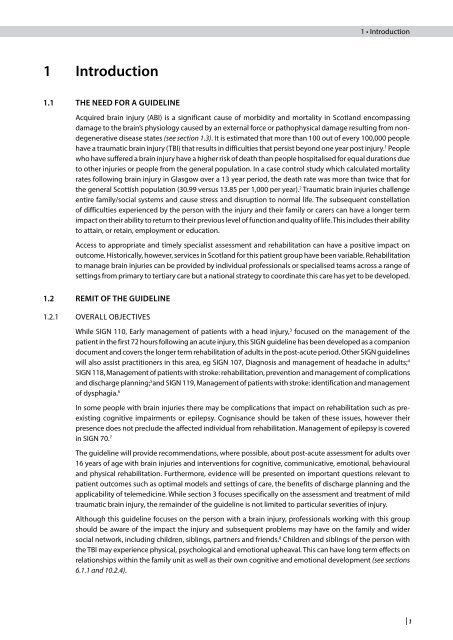sign130
sign130
sign130
Create successful ePaper yourself
Turn your PDF publications into a flip-book with our unique Google optimized e-Paper software.
1 Introduction<br />
1.1 THE NEED foR A GuIDElINE<br />
Acquired brain injury (ABI) is a significant cause of morbidity and mortality in Scotland encompassing<br />
damage to the brain’s physiology caused by an external force or pathophysical damage resulting from nondegenerative<br />
disease states (see section 1.3). It is estimated that more than 100 out of every 100,000 people<br />
have a traumatic brain injury (TBI) that results in difficulties that persist beyond one year post injury. 1 People<br />
who have suffered a brain injury have a higher risk of death than people hospitalised for equal durations due<br />
to other injuries or people from the general population. In a case control study which calculated mortality<br />
rates following brain injury in Glasgow over a 13 year period, the death rate was more than twice that for<br />
the general Scottish population (30.99 versus 13.85 per 1,000 per year). 2 Traumatic brain injuries challenge<br />
entire family/social systems and cause stress and disruption to normal life. The subsequent constellation<br />
of difficulties experienced by the person with the injury and their family or carers can have a longer term<br />
impact on their ability to return to their previous level of function and quality of life. This includes their ability<br />
to attain, or retain, employment or education.<br />
Access to appropriate and timely specialist assessment and rehabilitation can have a positive impact on<br />
outcome. Historically, however, services in Scotland for this patient group have been variable. Rehabilitation<br />
to manage brain injuries can be provided by individual professionals or specialised teams across a range of<br />
settings from primary to tertiary care but a national strategy to coordinate this care has yet to be developed.<br />
1.2 REMIT of THE GuIDElINE<br />
1.2.1 OVERALL OBjECTIVES<br />
1 • Introduction<br />
While SIGN 110, Early management of patients with a head injury, 3 focused on the management of the<br />
patient in the first 72 hours following an acute injury, this SIGN guideline has been developed as a companion<br />
document and covers the longer term rehabilitation of adults in the post-acute period. Other SIGN guidelines<br />
will also assist practitioners in this area, eg SIGN 107, Diagnosis and management of headache in adults; 4<br />
SIGN 118, Management of patients with stroke: rehabilitation, prevention and management of complications<br />
and discharge planning; 5 and SIGN 119, Management of patients with stroke: identification and management<br />
of dysphagia. 6<br />
In some people with brain injuries there may be complications that impact on rehabilitation such as preexisting<br />
cognitive impairments or epilepsy. Cognisance should be taken of these issues, however their<br />
presence does not preclude the affected individual from rehabilitation. Management of epilepsy is covered<br />
in SIGN 70. 7<br />
The guideline will provide recommendations, where possible, about post-acute assessment for adults over<br />
16 years of age with brain injuries and interventions for cognitive, communicative, emotional, behavioural<br />
and physical rehabilitation. Furthermore, evidence will be presented on important questions relevant to<br />
patient outcomes such as optimal models and settings of care, the benefits of discharge planning and the<br />
applicability of telemedicine. While section 3 focuses specifically on the assessment and treatment of mild<br />
traumatic brain injury, the remainder of the guideline is not limited to particular severities of injury.<br />
Although this guideline focuses on the person with a brain injury, professionals working with this group<br />
should be aware of the impact the injury and subsequent problems may have on the family and wider<br />
social network, including children, siblings, partners and friends. 8 Children and siblings of the person with<br />
the TBI may experience physical, psychological and emotional upheaval. This can have long term effects on<br />
relationships within the family unit as well as their own cognitive and emotional development (see sections<br />
6.1.1 and 10.2.4).<br />
| 1


